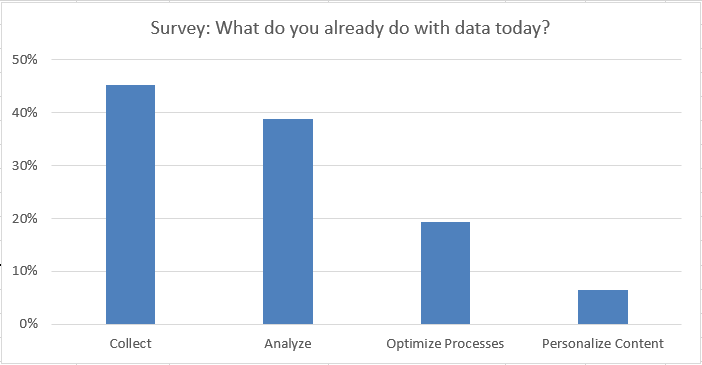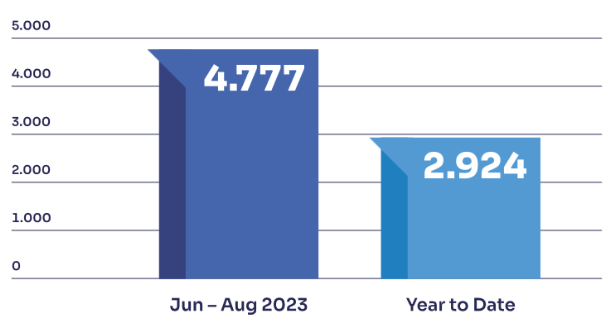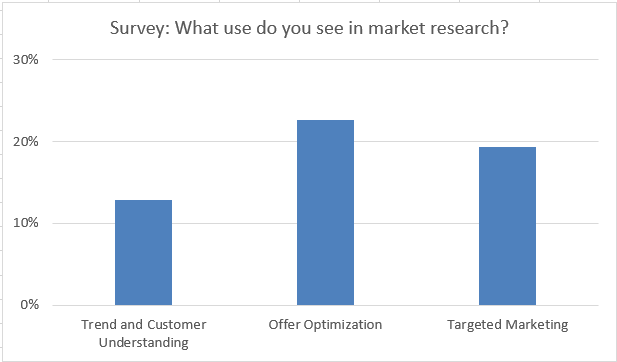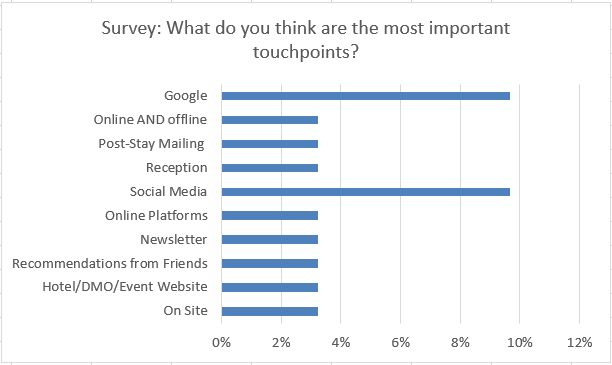We live in a data-driven world. Almost everything we come into contact with in our daily lives involves data in some way. The travel and hospitality industry is no exception, and TrustYou as a technology company is a big data analysis tool for the entire industry. André Kaufmann and Georg Thanner from TrustYou discussed what you can do with this data at DSTNCMP24 in Bregenz. Here is a summary of the presentation, as well as, an analysis of the surveys that participants answered during the event.
Data-Based Profiling as Key to Guest Loyalty

Almost half of the participants already collect data and nearly all of them analyze it afterwards – a good start, because collecting data without doing anything with it is a pointless pursuit. However, those who diligently collect data and fully utilize its potential gain the following advantages:
- 360 degree customer view
- Improvement of customer service
- Price optimization
- Back-office process optimization.
E-commerce companies such as Aldo and Groupon are already leading the way. Aldo is a Canadian-based footwear and accessories company that uses big data to successfully navigate their busiest periods of the year. The company works with a service-orientated big data architecture for its e-commerce. To do this, it integrates multiple data sources that cover payment, billing, and fraud detection. This integration project enables Aldo to provide a seamless e-commerce experience – even on Black Friday.
Groupon is an e-commerce website that offers subscribers discounts on activities, travel and other goods and services. To serve this large amount of customers, Groupon processes over a terabyte of raw data daily. This data set is too large to store and analyze without a big data platform. Groupon uses a large IT framework to import, integrate, transform and analyze data in real time. This allows them to run reports and visualize data from millions of customers in processable formats. With the help of this data, they can offer more targeted vouchers.
It is also worth collecting and analyzing data in a targeted manner in the hospitality industry. They can be used for the following purposes, among others:
- Visitor analyses: Tracking and analyzing visitor data to better understand target groups
- Marketing optimization: Adapting campaigns based on demographic data and visitor preferences
- Trend analyses: Identifying travel trends and patterns to plan future offers
- Feedback analysis: Utilizing reviews and social media to improve services and offers
- Resource management: Efficient management of tourism resources based on visitor data
Here are some examples of what this can look like in reality:
- Tourism New Zealand uses data analytics to track visitor origins and adapt their marketing strategies. By analyzing flight booking data and social media, they can create targeted advertizing campaigns for specific regions, leading to an increase in visitor numbers and more efficient use of resources.
- Visit Scotland uses data from various sources such as weather data, online booking platforms and social media to improve the visitor experience. This data helps to identify the best times and locations for different activities, allowing tourist flows to be better managed and overcrowding to be avoided. This contributes to sustainable development and visitor satisfaction.
- Travel Oregon has developed a data platform that provides real-time information on tourist movements. This platform collects data from mobile devices, credit card transactions and social media to identify patterns in visitor behaviour. These insights make it possible to precisely target marketing campaigns and better plan tourism infrastructure.
TrustYou as a Big Data Solution for Hospitality
TrustYou provides complex data processing and a precise understanding of millions of new customer reviews per week for millions of hotels, restaurants and attractions around the world. Powered by proprietary semantic processing and artificial intelligence, our technology delivers a wealth of analytics, KPIs and data points that have virtually unlimited applications in the travel industry and beyond.
If you take a closer look at the TrustYou data for Bregenz, for example, the great location is clearly the highlight with many positive reviews, while the Wi-Fi is a clear weak point. However, this is the case everywhere; smoothly functioning Wi-Fi is expected by guests, so there is no positive rating for it, but certainly a negative one if it is not available. You can also see what guests talk about most: Room quality is a favourite talking point, while the topic of sustainability is barely mentioned in reviews. If, on the other hand, we compare the number of reviews during the 2023 festival season with that in 2024 so far, we can see that far more reviews were written for the significantly shorter period in 2023 than for the longer period in 2024. More reviews mean more influence on the overall score, which means that the needle can be moved much more during the high season.

If you compare the same periods in other categories such as service, performance, value for money and response rate, Bregenz consistently performs better outside the high season. It may be that guests are more critical when prices skyrocket during the festival, but it may also be that the hospitality industry is simply unable to cope with the rush of visitors and service suffers as a result. Ultimately, evaluation management is a matter of expectation management.

Significance of Market Research and Customer Loyalty

The majority of participants see the advantage of market research in being able to better understand trends and customers in order to conduct more targeted marketing and create better optimized offers. Optimized offers mean better reviews and possibly more customer loyalty, because:
- 95% of all travellers read reviews before making a booking – on average 9 reviews before a booking decision is made.
- According to Skift Research, repeat travellers account for 30-60% of total bookings in accommodation, a not insignificant proportion.
- Returning customers generate 67% more revenue than new customers.
- According to Priceline, researching and planning a trip can feel like a full-time job. On average, travellers spend the equivalent of two full working days or 16 hours researching, planning and booking.
Reviews (and by extension review management) are therefore important and regular guests deliver more ROI than new customers. Besides, there are an incredible number of touchpoints between destinations and their guests during the travel planning process, which destinations should use to their advantage. This is also an opportunity to gain loyal repeat customers by making this lengthy process easier for them.
Touchpoints during Research, Booking and Beyond

As you can see from the large number of answers, there is a huge range of touchpoints during a typical customer journey. (This blog post takes a closer look at them using a fictitious example.)
However, beyond all those touchpoints, the possibilities for customer profiling can be exploited even further. By collecting data such as the duration of the trip, accommodation, revenue, booking type, room category and language, combined with demographic information such as age and gender as well as email address, a detailed customer profile can be created and used to market further visits with the help of optimized offers.
